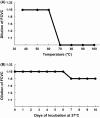Isolation of viable but nonculturable Vibrio cholerae O1 from environmental water samples in Kolkata, India, in a culturable state
- PMID: 24574069
- PMCID: PMC3996571
- DOI: 10.1002/mbo3.164
Isolation of viable but nonculturable Vibrio cholerae O1 from environmental water samples in Kolkata, India, in a culturable state
Abstract
Previously, we reported that viable but nonculturable (VBNC) Vibrio cholerae was converted into a culturable state by coculture with several eukaryotic cell lines including HT-29 cells. In this study, we found that a factor converting VBNC V. cholerae into a culturable state (FCVC) existed in cell extracts of eukaryotic cells. FCVC was nondialyzable, proteinase K-sensitive, and stable to heating at <60°C for 5 min. We prepared thiosulfate citrate bile salts sucrose (TCBS) plates with FCVC (F-TCBS plates). After confirming that VBNC V. cholerae O1 and O139 formed typical yellow colonies on F-TCBS plates, we tried to isolate cholera toxin gene-positive VBNC V. cholerae from environmental water samples collected in urban slum areas of Kolkata, India and succeeded in isolating V. cholerae O1 El Tor variant strains harboring a gene for the cholera toxin. The possible importance of VBNC V. cholerae O1 as a source of cholera outbreaks is discussed.
Keywords: Factor converting VBNC into culturable; VBNC Vibrio cholerae.
© 2014 The Authors. MicrobiologyOpen published by John Wiley & Sons Ltd.
Figures





Similar articles
-
A factor converting viable but nonculturable Vibrio cholerae to a culturable state in eukaryotic cells is a human catalase.Microbiologyopen. 2015 Aug;4(4):589-96. doi: 10.1002/mbo3.264. Epub 2015 May 13. Microbiologyopen. 2015. PMID: 25974870 Free PMC article.
-
Demonstration of viable but nonculturable Vibrio cholerae O1 in fresh water environment of India using ciprofloxacin DFA-DVC method.Lett Appl Microbiol. 2011 Jul;53(1):124-6. doi: 10.1111/j.1472-765X.2011.03077.x. Epub 2011 May 31. Lett Appl Microbiol. 2011. PMID: 21554341
-
Stepwise changes in viable but nonculturable Vibrio cholerae cells.Microbiol Immunol. 2015 May;59(5):305-10. doi: 10.1111/1348-0421.12246. Microbiol Immunol. 2015. PMID: 25664673
-
Inland cholera in freshwater environs of north India.Vaccine. 2020 Feb 29;38 Suppl 1:A63-A72. doi: 10.1016/j.vaccine.2019.06.038. Epub 2019 Jul 3. Vaccine. 2020. PMID: 31279566 Review.
-
Diagnostic techniques for rapid detection of Vibrio cholerae O1/O139.Vaccine. 2020 Feb 29;38 Suppl 1:A73-A82. doi: 10.1016/j.vaccine.2019.07.099. Epub 2019 Aug 16. Vaccine. 2020. PMID: 31427135 Review.
Cited by
-
Evidence-Based Health Behavior Interventions for Cholera: Lessons from an Outbreak Investigation in India.Am J Trop Med Hyg. 2021 Oct 25;106(1):229-232. doi: 10.4269/ajtmh.21-0625. Am J Trop Med Hyg. 2021. PMID: 34695790 Free PMC article.
-
Significance of Viable But Non-culturable (VBNC) State in Vibrios and Other Pathogenic Bacteria: Induction, Detection and the Role of Resuscitation Promoting Factors (Rpf).Curr Microbiol. 2024 Oct 21;81(12):417. doi: 10.1007/s00284-024-03947-8. Curr Microbiol. 2024. PMID: 39432128 Review.
-
Optimization of resuscitation-promoting broths for the revival of Vibrio parahaemolyticus from a viable but nonculturable state.Food Sci Biotechnol. 2020 Nov 18;30(1):159-169. doi: 10.1007/s10068-020-00843-2. eCollection 2021 Jan. Food Sci Biotechnol. 2020. PMID: 33552627 Free PMC article.
-
Induction and Resuscitation of Viable but Nonculturable Corynebacterium diphtheriae.Microorganisms. 2021 Apr 26;9(5):927. doi: 10.3390/microorganisms9050927. Microorganisms. 2021. PMID: 33925877 Free PMC article.
-
A factor converting viable but nonculturable Vibrio cholerae to a culturable state in eukaryotic cells is a human catalase.Microbiologyopen. 2015 Aug;4(4):589-96. doi: 10.1002/mbo3.264. Epub 2015 May 13. Microbiologyopen. 2015. PMID: 25974870 Free PMC article.
References
-
- Aulet O, Silva C, Fraga SG, Pichel M, Cangemi R, Gaudioso C. Detection of viable and viable nonculturable Vibrio cholerae O1 through cultures and immunofluorescence in the Tucumán rivers, Argentina. Rev. Soc. Bras. Med. Trop. 2007;40:385–390. - PubMed
Publication types
MeSH terms
Substances
LinkOut - more resources
Full Text Sources
Other Literature Sources

